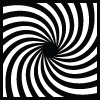One of those strange factoids I’ve picked up over the last few decades of my life is that frogs don’t see things the way we see things. Frogs have excellent color vision and can see colors at night, but the most important distinction (at least for this blog post) is that frogs primarily hunt via the perception of movement.
The frog does not seem to see or, at any rate, is not concerned with the detail of stationary parts of the world around him. He will starve to death surrounded by food if it is not moving. His choice of food is determined only by size and movement. He will leap to capture any object the size of an insect or worm, providing it moves like one.
— J. Y. LETTVINt, H. R. MATURANAT, W. S. McCULLOCH||, SENIOR MEMBER, IRE,
AND W. H. PITTS; “What The Frog’s Eye Tells The Frog’s Brain”
In other words, when a frog spends hours staring into space, what stands out for them is what changes in their vision.
Testing Reverbs with Tom’s Diner
I have found myself in a similar situation over the last few decades when testing reverbs. When I am listening to a new reverb algorithm, I tend to use the same source material repeatedly. My standard test suite consists of some vocal tracks from Don Gunn, a single sample click, dry piano recordings (to hear the effects of modulation on the signal), dry drum tracks, and the old standby of DSP developers: “Tom’s Diner (A Cappella)” by Suzanne Vega.
The ubiquity of “Tom’s Diner (A Cappella)” as a test signal has become an in-joke among audio DSP developers. In 2001, I heard a composition from a DSP developer at Creative Labs at a Santa Cruz concert, made around manipulations of “Tom’s Diner.” Many of the folks in the audience had a knowing chuckle, as they had heard “Tom’s Diner” playing soooooo many times in their office. Twenty years later, I still turn to “Tom’s Diner” all the time for testing new algorithms.
Why “Tom’s Diner”?
In many ways, it is ideal for all sorts of audio DSP testing. It is a solo female voice, with almost no reverb applied, recorded in a professional environment. This is perfect for testing pitch tracking, PSOLA pitch shifting, reverbs, compression, and so on. However, the most important factor for me is that I have heard “Tom’s Diner” so many times that I no longer hear it. Like frog vision, I no longer notice what remains the same, only what has changed. I don’t hear the song anymore, just the different ways that my DSP algorithms respond to it.
Observing Nuances in Sound through Repetition
I’ve been working on DSP algorithms since 1998. I’ve learned a lot over the past 23 years. Perhaps more importantly, I’ve learned to observe sound to a degree I would never have imagined back in the 90s. By listening to things obsessively, day in and day out, I can hear more and more nuances in my algorithms. These observation skills have led to me (hopefully) producing better algorithms. By using that same dang Suzanne Vega track repeatedly, I can focus my observation on things that have changed between different algorithms or different variants on the same algorithm. The repetition can be maddening at times, but the results are worth it.





Brilliant stuff !
We can all become hyper-tuned to our environment if we allow ourselves. I had a cockroach infestation a few times and found that I became acutely aware of tiny marks surrounding me all the time and pounced as if on guard. After they went, so did the behaviour.
As to sound, well I wouldn’t be here if that wasn’t also my life since I was about 3. We just hear everything in a different way, like x ray vision !
I only stopped by to see if there was anything new, I love the plug-ins, have most and pretty much use them exclusively on all my work. Thank you !
Fascinating. Love it!